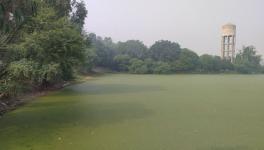Alarming Dip in Groundwater Level in Punjab, Haryana: Kanpur IIT Study
New Delhi: The groundwater level in northwest India has dipped to alarming levels, especially in Punjab and Haryana, according to a new study.
The research paper, published by IIT Kanpur, has used more than 4,000 groundwater well data from northwest India to demonstrate that groundwater levels in the states of Punjab and Haryana have fallen to alarming levels in the past four-five decades.
India is the largest user of groundwater in the world for irrigation, domestic and industrial needs. The total annual groundwater abstraction in India is about 245 km, out of which about 90% is consumed for irrigation.
Several parts of the Ganga plains are currently suffering from similar over-exploitation of groundwater and it may still be time to arrest the situation if proper strategies can be designed for groundwater management, it said.
Punjab and Haryana are the worst affected region and the study led by Prof. Rajiv Sinha and his PhD student, Suneel Kumar Joshi, at IIT Kanpur shows that shallow groundwater fell from 2 metres below ground level (bgl) during 1974, to about 30 metres bgl in 2010.
This translates to an average loss of groundwater of more than 50 km3 (1.0 km3/yr), particularly after 2002.
“The situation is equally bad for states like UP and Bihar which are agriculture dominated states and where the groundwater management strategies are still quite primitive,” the study said.
The study reveals that the rice cultivation area increased from 1,92,000 to 14,22,000 hectares between 1966-67 and 2017-18 for Haryana and from 2,27,000 to 30,64,000 hectares between 1960-61 and 2017-18 in Punjab.
As a result, groundwater abstraction increased to fulfil the demand.
Also, the most significant decline in groundwater levels is recorded along the Ghaggar-Hakra paleochannel (Kurukshetra, Patiala and Fatehabad districts), and in along the incised valley of the Yamuna River (parts of Panipat and Karnal districts).
The authors suggest that the rate of groundwater abstraction in Punjab and Haryana, which make up the leading agricultural region of India, rose sharply since the mid-20th century to support a massive increase in agricultural productivity, termed the “Green Revolution,” which was aimed at achieving self-sufficiency in food production.
The Green Revolution has been cited as the primary cause behind the dramatic fall in groundwater levels in the region through uncontrolled pumping and groundwater abstraction by several workers before but this paper provides high resolution data on groundwater level change to validate this hypothesis.
An important finding of this paper is that local geomorphology like positions of former channel paleochannels), control the groundwater availability in a major way and creates a strong spatial heterogeneity in depletion patterns over time.
The study has significant implications for designing sustainable strategies for groundwater management not only for northwest India but for most of the Ganga plains covering parts of UP and Bihar.
“Several areas in north-central Punjab and Haryana recorded a rapid fall in groundwater levels that require immediate action in terms of enhanced monitoring of groundwater level change and intervention to mitigate against pressure from abstraction,” the study said.
The option of artificial recharge as a mitigation strategy should be guided by the geomorphic setting, which is easier to map and is strongly linked to subsurface stratigraphy as demonstrated by the study, it suggested
In areas where agriculture is the most significant causal factor for the severe groundwater losses, reducing irrigation water demand must be a high priority in these districts to improve the groundwater situation, it added.
In areas with thick and abundant aquifer bodies in the subsurface, managed aquifer recharge or groundwater bankingis also feasible, the study said.
For areas where saline groundwater is present at shallow levels, artificial recharge schemes would be counter-productive, and would in any event suffer from low efficiency due to the limited amounts of aquifer material in the subsurface.
Instead, rainwater harvesting combined with the development of channelised irrigation systems may be a good option in such areas, it added.
The research was funded by the Ministry of Earth Sciences, and Natural Environment Research Council (NERC), UK, with support from the Central Groundwater Board (CGWB) under the Jal Shakti Ministry.
Get the latest reports & analysis with people's perspective on Protests, movements & deep analytical videos, discussions of the current affairs in your Telegram app. Subscribe to NewsClick's Telegram channel & get Real-Time updates on stories, as they get published on our website.
























